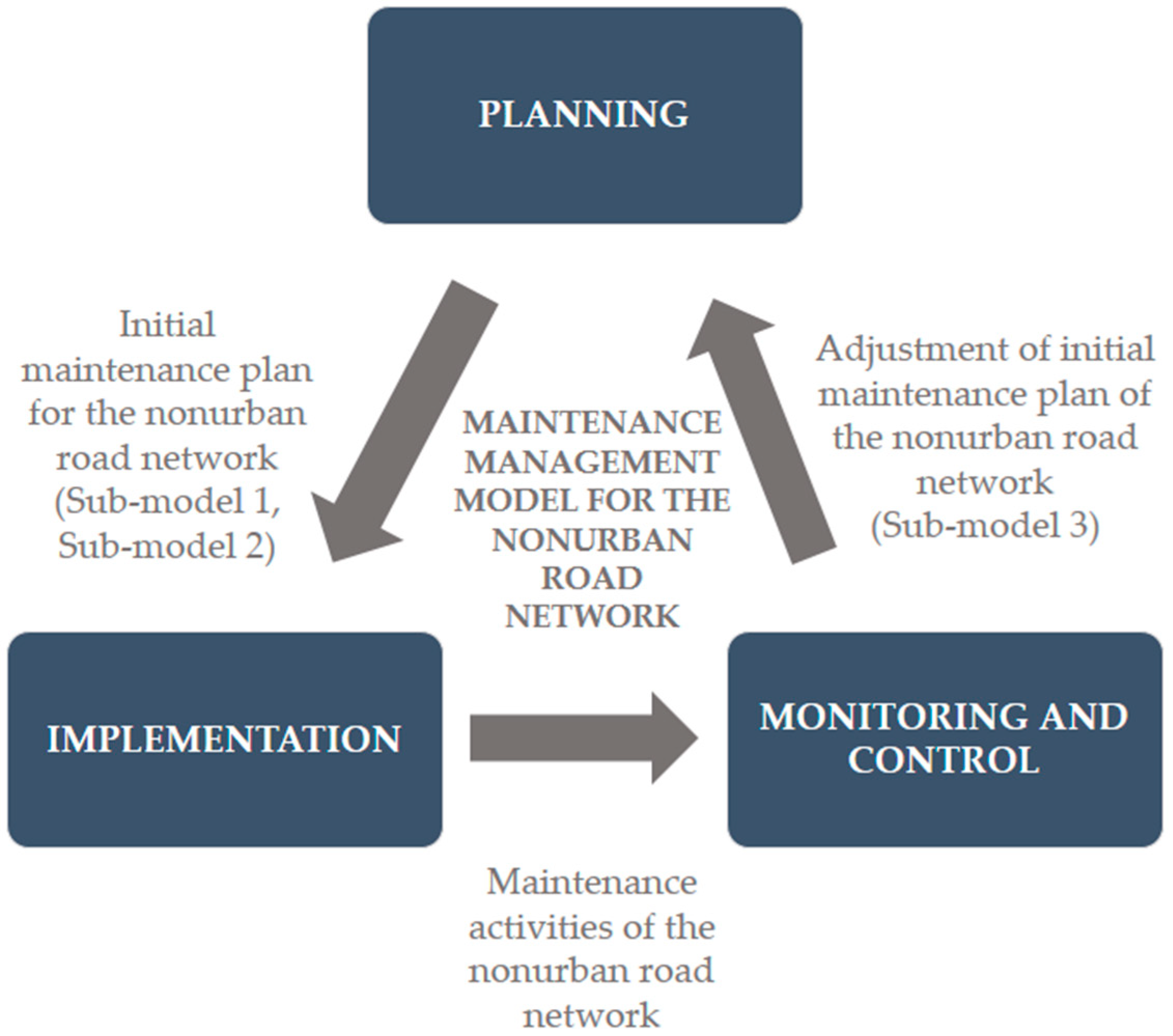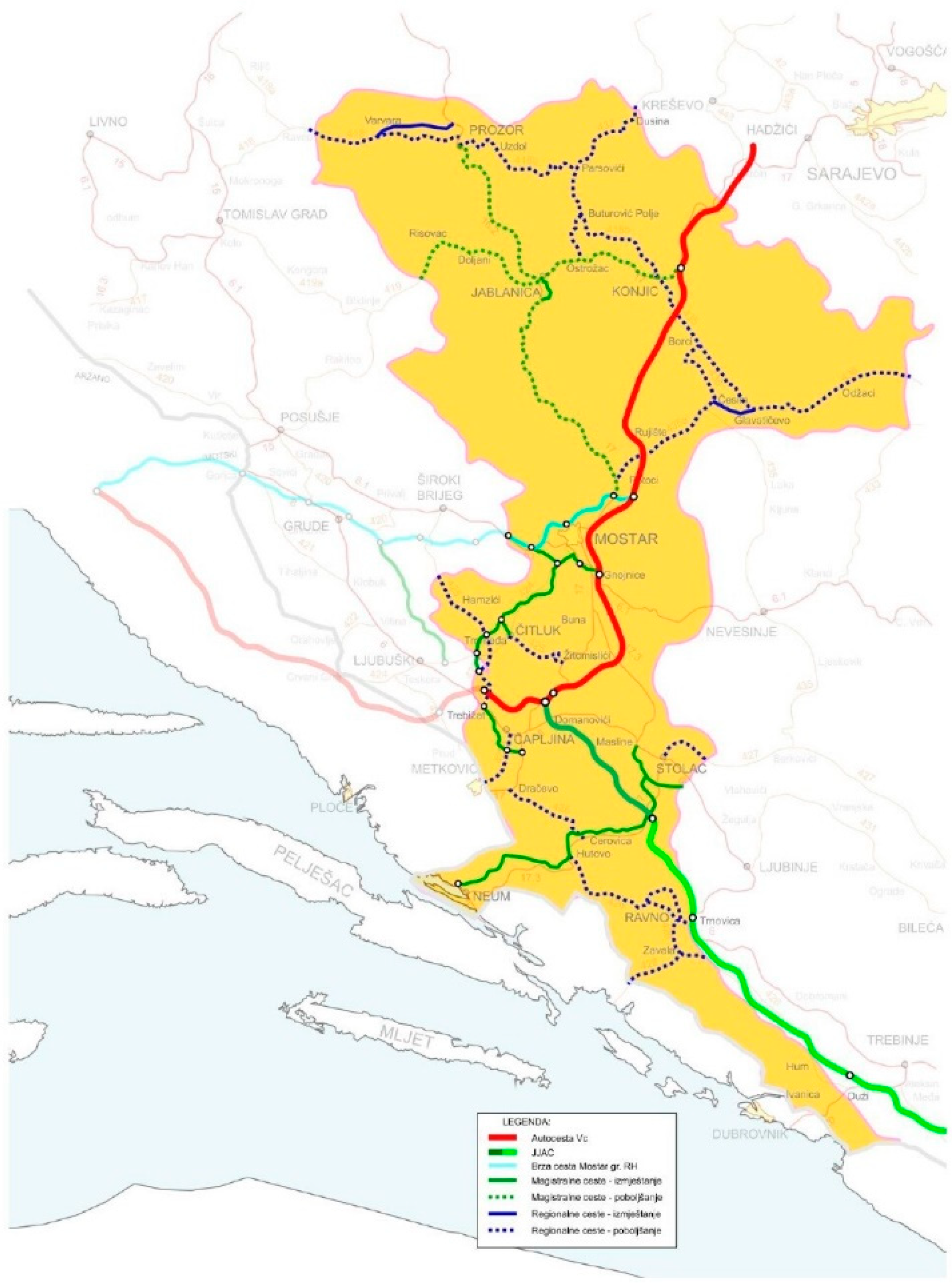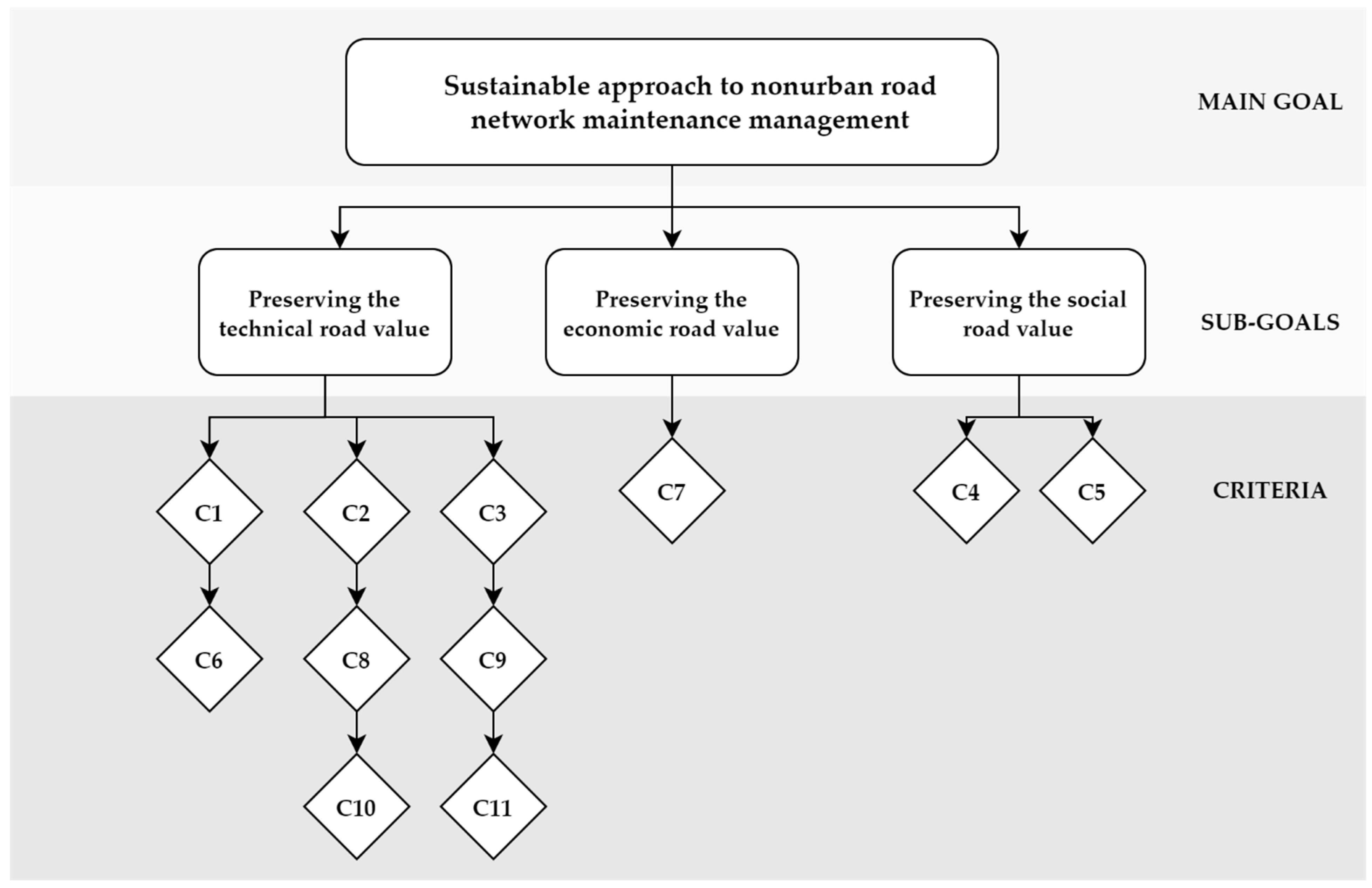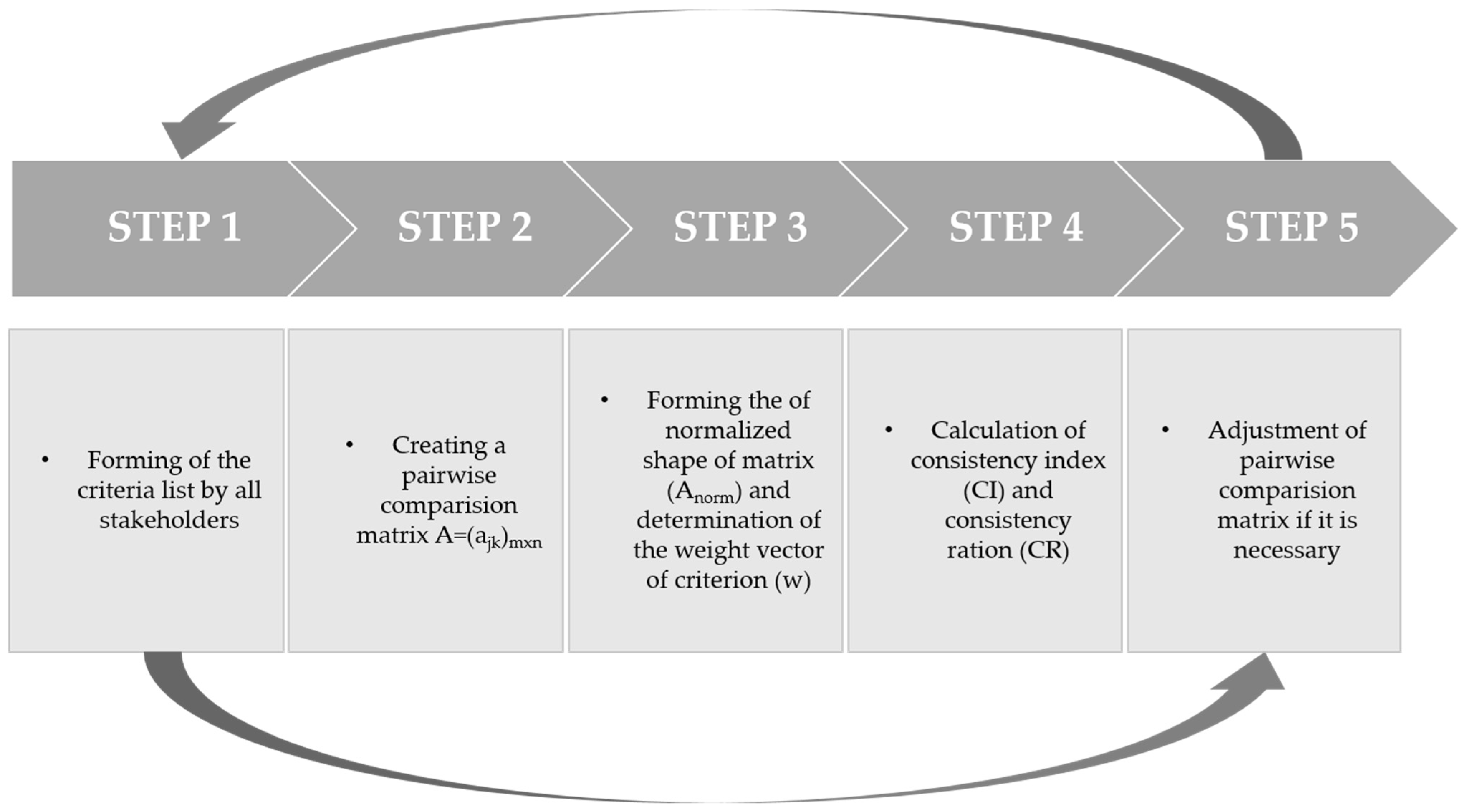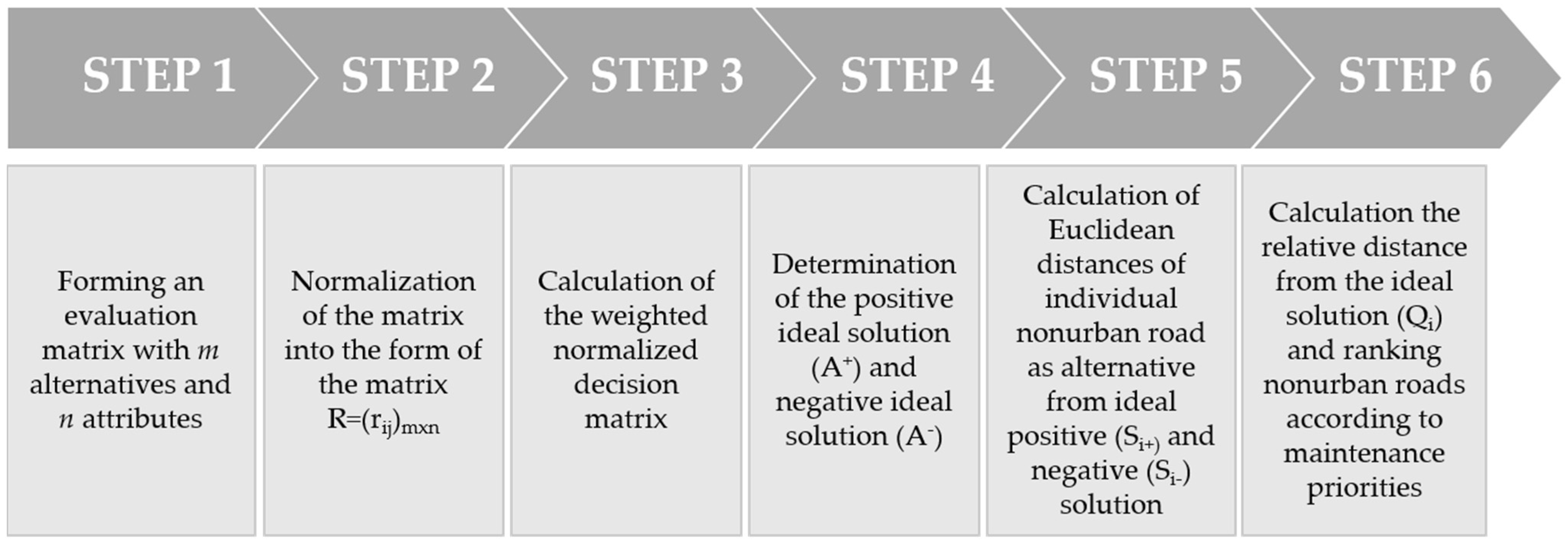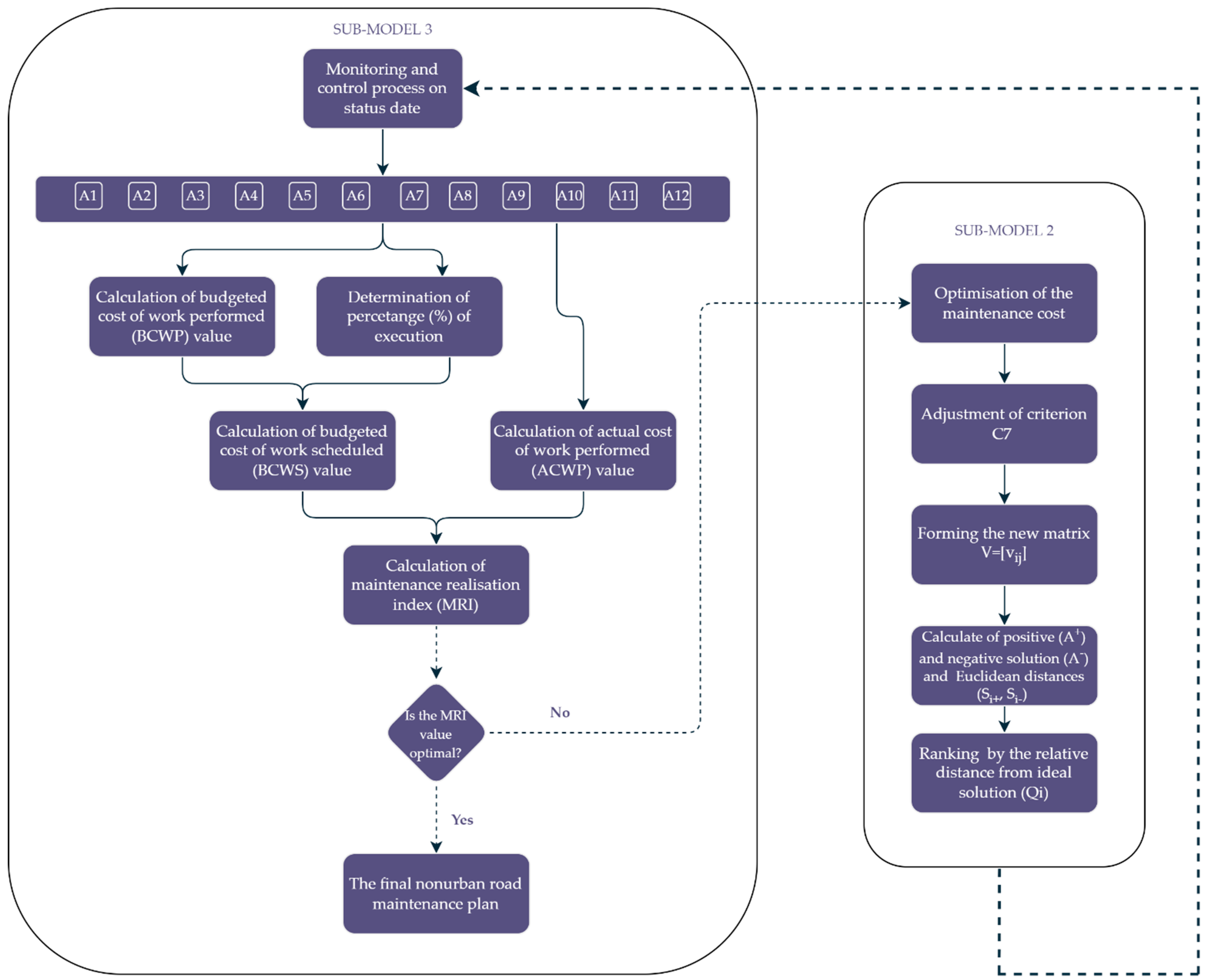As part of the last two steps of the planning process and as an integral part of the nonurban road network maintenance management model, two sub-models are established based on the application of selected multicriteria decision-making methods.
2.1.2. Establishment of a Hierarchical Structure of Goals
The first step in solving poorly structured problems, such as the problem of maintaining the nonurban road network, is the establishment of a hierarchical structure of goals, in which the previously mentioned nonurban roads represent alternatives in priority maintenance.
The hierarchical structure of goals in this research is defined by a sustainable approach to nonurban road network maintenance as a main goal. According to compromise solution of all stakeholders involved in the decision-making process, the first level of objectives contains preserving technical road value, i.e., maximization of technical road characteristics, preserving the economic road value as maximization of economic indicators and preserving the social road value as maximization of social benefits. The last level in the presented hierarchy structure of goals (HSG) represents criteria which are used for multicriteria analysis. Preservation of the road’s technical value is divided into eight technical criteria (C1, C2, C3, C6, C8, C9, C10, and C11), three of which affect the ecological aspect of maintenance, such as traffic intensity (C1), length (C2) and width of the nonurban road (C9). Preservation of the economic road value is expressed through maintenance cost as economic criteria (C7). Finally, preserving the social road value is divided into two social criteria (C4 and C5). The mentioned criteria are included in the hierarchical structure of goals as indicators of the state of nonurban roads that could be measured on the ground at the time of the research. The described hierarchical structure of the goals is shown in
Figure 4 and the criteria, with a description of the criteria, are given in
Table 1.
The identified stakeholders are divided into three expert groups, where the first expert group consists of users as the population living in the observed nonurban area. Each nonurban area consists of one observed regional road, and one resident from each nonurban area was taken as a respondent, i.e., a total of 12 respondents, which corresponds to the total number of observed regional roads in the case study.
The second expert group consists of representatives of the regional administration, i.e., the Ministry of Transport and Communications of Herzegovina-Neretva County, to which the observed regional roads belong.
Finally, the third interest group consists of the road and maintenance experts, i.e., university professors with a research area in organization, technology, maintenance management and roads from the Faculty of Civil Engineering, Architecture and Geodesy, University of Split in Croatia, and from the Faculty of Civil Engineering, Architecture and Geodesy, University of Mostar in Bosnia and Herzegovina. With the aim of preserving the technical, economic and social value of nonurban roads as sub-goals within the hierarchical structure of goals, a total of 11 criteria are defined and described in detail in
Table 1.
The presented criteria were selected based on the possibility of collecting data on an individual road section or alternatively by recording the real condition of observed nonurban roads. In addition to the above criteria, safety criteria expressed in the number of traffic accidents on individual roads can be of great importance in determining maintenance priorities. Although a lot of effort has been placed by agencies across the world to reduce the number and severity of crashes, the effects of crashes on road transport networks are still a major source of morbidity and, according to World Health Organization (WHO), road traffic injuries are ranked eighth as the leading cause of death among people of all ages. Because of that, it is very important to take accidents data into account and to incorporate these into some of the methods utilized for assessing safety [
23]. For example, Fu and Sayed [
24] propose a multivariate method for evaluating real-time safety from conflict extremes, which consists of novel multivariate extreme value theory (EVT) models. The proposed approach presents flexible integration of multiple conflict indicators and several joint safety indices that comprehensively characterize the safety level of a road facility from multiple dimensions. Until the moment of this research, only summary data for observed nonurban road network were collected, which are visible in
Table 2, but the application of the described approach to safety assessment on the nonurban road network can certainly represent one of the directions of future research.
In contrast to the traditional approach to the analysis of road maintenance management solutions, which was mainly based on the distribution of financial resources, i.e., economic criteria, the proposed approach to nonurban road network maintenance management is based on three spheres of sustainability, taking into account economic, social and environmental aspect problems when determining the priority of the observed road. However, the hierarchical structure of goals (HSG) presented in
Figure 4 consists of selected economic, technical and social criteria. Since some of the selected technical criteria are directly related to ecological criteria and, therefore, give the same rank of maintenance priority, only technical criteria were taken into account. For example, the inter-relationship between the average annual daily traffic (C1) as a technical criterion and the CO
2 emission level as an environmental criterion is shown in
Table 3. Therefore, the observed nonurban roads were ranked only according to the defined technical criteria but detailed analysis of the impact on the environment of certain nonurban roads, the definition of a series of ecological criteria and the reranking of roads also can represent one of the directions of future research.
Furthermore,
Table 4 shows the labels, names and lengths of observed nonurban roads as alternative solutions in maintenance management, making up a network of regional roads in Herzegovina-Neretva County, which need to be ranked according to the priority of maintenance.
After defining the research area and the hierarchical structure of goals, a sub-model of determination of the relative weights of criteria and a sub-model for priority ranking of nonurban roads is applied within the model of nonurban road network maintenance management. By implementing these two sub-models, which are described in detail below, and by distributing limited financial resources according to maintenance priorities, a maintenance plan is formed. This maintenance plan is further applied as input information for the management process of monitoring and control of nonurban road maintenance.
2.1.3. Sub-Model for Determination of Relative Criteria Weight
The sub-model for determination of relative weight of the identified criteria as a compromise solution for all stakeholders involved in the decision-making process about nonurban road maintenance management is based on the application of the analytical hierarchical approach (AHP) as one of the best-known and most-used multicriteria decision-making methods. According to
Figure 5, steps by which this sub-model can be applied to the regional road network of Herzegovina-Neretva County in Bosnia and Herzegovina are:
Forming of the criteria list by all stakeholders divided into three expert groups (users, regional administration and recognized experts in the field of management and roads);
Comparing each identified criteria by each stakeholder using the Saaty scale and creating a pairwise comparison matrix A = (ajk)nxn;
Forming of the normalized shape of matrix (Anorm) and determination of the weight vector of the criterion (w), which is equal to the arithmetic mean of each row in the normalized matrix;
Calculation of consistency index (CI) and consistency ratio (CR);
Recomparison of criteria in pairs and adjustment of pairwise comparison matrix if it is necessary (CR > 0.1).
In the first step of the presented sub-model, it is necessary to form a list of criteria from the hierarchical structure of goals, with which involved stakeholders will compare the criteria with each other using the fundamental scale [
25,
26] and forming a comparison matrix A = (a
jk)
nxn where n presents the number of considered evaluation criteria. Each element of matrix a
jk presents the importance of the jth criterion in relation to the kth criterion. After that, in the following step, it is necessary to form the normalized shape of matrix (B
norm), where each element is computed as:
Determination of each criterion weight vector is computed as the arithmetic mean of each row in the normalized matrix (B
norm) as follows:
In the fourth step, with the aim of checking the consistency of the assessment, it is necessary to calculate consistency ratio (CR) based on relation of the consistency index (CI) and the random consistency index (RI). If the consistency ratio (CR) is greater than 0.1, inconsistent decisions of the involved stakeholders have been made and, in the fifth step, it is necessary to form a new comparison matrix and repeat the procedure until the CR value is less than 0.1 [
27].
As mentioned earlier, one of the reasons for the complexity and poor structure of the problem of nonurban road maintenance management is the large number of stakeholders with different opinions, requirements and interests. Therefore, in the application of the sub-model for determination of the weight of criteria, all included stakeholders are divided into three expert groups, where each group separately determines the weights of individual criteria, and the compromise solution is obtained as the arithmetic mean of three different scenarios related to a particular expert group.
